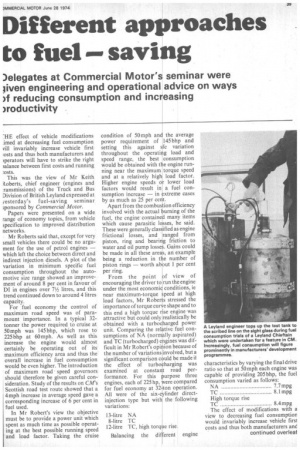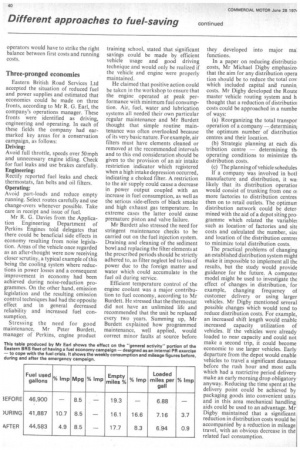Different approaches to fuel Asaving
Page 41

Page 42

If you've noticed an error in this article please click here to report it so we can fix it.
)elegates at Commercial Motor's seminar were liven engineering and operational advice on ways Yf reducing consumption and increasing noductivity
HE effect of vehicle modifications .imed at decreasing fuel consumption vill invariably increase vehicle first :osts and thus both manufacturers and iperators will have to strike the right mlance between first costs and running :osts.
This was the view of Mr Keith koberts, chief engineer (engines and ransmissions) of the Truck and Bus Division of British Leyland expressed at (esterday's fuel-saving seminar sponsored by Commercial Motor.
Papers were presented on a wide range of economy topics, from vehicle specification to improved distribution networks.
Mr Roberts said that, except for very small vehicles there could be no argument for the use of petrol engines — which left the choice between direct and indirect injection diesels. A plot of the variation in minimum specific fuel consumption throughout the automotive size range showed an improvement of around 8 per cent in favour of DI in engines over 71/2 litres, and this trend continued down to around 4 litres capacity.
For fuel economy the control of maximum road speed was of paramount importance. In a typical 32tonner the power required to cruise at 50 mph was 145 bhp, which rose to 225 bhp at 60 mph. As well as this increase the engine would almost certainly be operating out of its maximum efficiency area and thus the overall increase in fuel consumption would be even higher. The introduction of maximum road speed governors should therefore be given careful consideration. Study of the results on CM's Scottish road test route showed that a 4 mph increase in average speed gave a corresponding increase of 6 per cent in fuel used.
In Mr Robert's view the objective must be to provide a power unit which spent as much time as possible operating at the best possible running speed and load factor. Taking the cruise condition of 50 mph and the average power requirement of 145 bhp and setting this against sfc variation throughout the operating load and speed range, the best consumption would be obtained with the engine running near the maximum torque speed and at a relatively high load factor. Higher engine speeds or lower load factors would result in a fuel consumption increase — in extreme cases by as much as 25 per cent.
Apart from the combustion efficiency involved with the actual burning of the fuel, the engine contained many items which cause parasitic losses, he said. These were generally classified as engine frictional losses, and ranged from piston, ring and bearing friction to water and oil pump losses. Gains could be made in all these areas, an exampre being a reduction in the number of piston rings — worth about 1 per cent per ring.
From the point of view of encouraging the driver to run the engine under the most economic conditions, ie near maximum-torque speed at high load factors, Mr Roberts stressed the importance of torque curve shape and to this end a high torque rise engine was attractive but could only realistically be obtained with a turbocharged power unit. Comparing the relative fuel consumptions of NA (normally aspirated) and TC (turbocharged) engines was difficult in Mr Robert's opinion because of the number of variations involved, but a significant comparison could be made if the effect of turbocharging was examined at constant road performance. For this purpose three engines, each of 225 hp, were compared for fuel economy at 32-ton operation. All were of the six-cylinder directinjection type but with the following variations: 13-litre NA 8-litre TC 12-litre TC, high torque rise Balancing the different engine characteristics by varying the final drive ratio so that at 50 mph each engine was capable of providing 205 bhp, the fuel consumption varied as follows: NA 7.7 mpg TC 8.1mpg High torque rise TC 8.4mpg The effect of modifications with a view to decreasing fuel consumption would invariably increase vehicle firsl costs and thus both manufacturers and operators would have to strike the right balance between first costs and running costs.
Three-pronged economies
Eastern British Road Services Ltd accepted the situation of reduced fuel and power supplies and estimated that economies could be made on three fronts, according to Mr R. G. Earl, the company's operations manager. These fronts were identified as driving, engineering and operating. In each of these fields the company had earmarked key areas for a conservation campaign, as follows:
Driving:
Avoid full throttle, speeds over 50mph and unnecessary engine idling. Check for fuel leaks and use brakes carefully. Engineering: Rectify reported fuel leaks and check thermostats, fan belts and oil filters. Operating: Avoid part-loads and reduce empty running. Select routes carefully and use change-overs whenever possible. Take care in receipt and issue of fuel.
Mr R. G. Davies from the Application Engineering Department of Perkins Engines told delegates that there could be beneficial side effects in economy resulting from noise legislation. Areas of the vehicle once regarded as an after-thought were now receiving closer scrutiny, a typical example of this being the cooling system where reductions in power losses and a consequent improvement in economy had been achieved during noise-reduction programmes. On the other hand, emission legislation and the resulting emission control techniques had had the opposite effect and in general decreased reliability and increased fuel consumption.
Stressing the need for good maintenance, Mr Peter Burdett, manager of Perkins, engine product training school, stated that significant savings could be made by efficient vehicle usage and good driving technique and would only be realized if the vehicle and engine were properly maintained.
He claimed that positive action could be taken in the workshop to ensure that the engine operated at peak performance with minimum fuel consumption. Air, fuel, water and lubrication systems all needed their own particular regular maintenance and Mr Burdett thought that simple routine maintenance was often overlooked because of its very basic nature. For example, air filters must have elements cleaned or removed at the recommended intervals and to this end consideration should be given to the provision of an air intake restriction indicator which registered when a high intake depression occurred, indicating a choked filter. A restriction to the air supply could cause a decrease in power output coupled with an increase in fuel consumption, as well as the serious side-effects of black smoke and high exhaust gas temperature. In extreme cases the latter could cause premature piston and valve failure.
Mr Burdett also stressed the need for stringent maintenance checks to be carried out on the fuel injection system. Draining and cleaning of the sediment bowl and replacing the filter elements at the prescribed periods should be strictly adhered to, as filter neglect led to loss of power due to the foreign matter and water which could accumulate in the fuel oil during service.
Efficient temperature control of the engine coolant was a major contribution to fuel economy, according to Mr Burdett. He stressed that the thermostat did not have an unlimited life and recommended that the unit be replaced every two years. Summing up, Mr Burdett explained how programmed maintenance, well applied, would correct minor faults at source before they developed into major mal functions.
In a paper on reducing distributio costs, Mr Michael Digby emphasize' that the aim for any distribution opera tion should be to reduce the total cos' which included capital and runnin, costs. Mr Digby developed the Route master vehicle routing system and h thought that a reduction of distributioi costs could be approached in a numbe of ways: (a) Reorganizing the total transpor operation of a company —,determininl the optimum number of distributioi centres and their location.
(b) Strategic planning at each dis tribution centre — determining flit operating conditions to minimize till distribution costs.
• (c) The planning of vehicle schedules If a company was involved in boll manufacture and distribution, it wai likely that its distribution operatior would consist of trunking from one 01 more factories to distribution centres then on to retail outlets. The optimun distribution network could be deter. mined with the aid of a depot siting programme which related the variable such as location of factories and sitc costs and calculated the number, sizt and location of the distribution centreE to minimize total distribution costs.
The practical problems of changing an established distribution system might make it impossible to implement all the results, but the study would provide guidance for the future. A computer model might be used to investigate the effect of changes in distribution, for example, changing frequency of customer delivery or using larger vehicles. Mr Digby mentioned several possible changes which would tend to reduce distribution costs. For example, an increased shift length would enable increased capacity utilization of vehicles. If the vehicles were already loaded to near capacity and could not make a second trip, it could become economic to use larger vehicles. Early departure from the depot would enable vehicles to travel a significant distance before the rush hour and most calls which had a restrictive period delivery make an early morning drop obligatory. anyway. Reducing the time spent at the delivery point could be achieved by packaging goods into convenient units and in this area mechanical handling aids could be used to an advantage. Mr' Digby maintained that a significant reduction in distribution costs would be accompanied by a reduction in mileage travel, with an obvious decrease in the related fuel consumption.












































































































